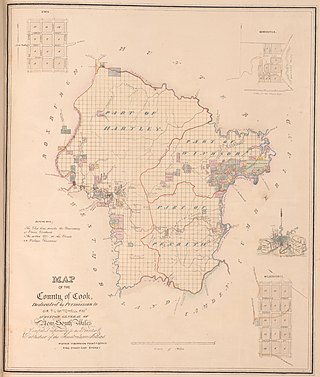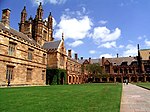Related Research Articles

Cook and Westmoreland was an electoral district of the Legislative Assembly in the Australian state of New South Wales in the first and second Parliaments (1856–1859), named after Cook and Westmoreland counties in the Blue Mountains, Lithgow and Oberon areas. It elected two members simultaneously, with voters casting two votes and the first two candidates being elected. It was largely replaced by Hartley, however both members moved to other electorates, James Martin became the member for East Sydney, while Robert Jamison became the member for Nepean.
Sydney Hamlets was an electoral district of the Legislative Assembly in the British colony of New South Wales created in 1856 and abolished in 1859. The district was established in 1856 with the new parliament, consisting of the elected Legislative Assembly and an appointed Legislative Council, which replaced the unicameral Legislative Council in which 36 of the 54 members were elected and the other 18 were appointed
Cumberland (North Riding) was an electoral district of the Legislative Assembly in the Australian state of New South Wales from 1856 to 1859, in Cumberland County, which includes Sydney. It included all of the county north of Parramatta Road and the Great Western Highway, except for the urban electorates of Sydney (City), Sydney Hamlets, Parramatta and Cumberland Boroughs, which included Richmond and Windsor. It elected two members simultaneously, with voters casting two votes and the first two candidates being elected. It was abolished in 1859 and the district was divided between Central Cumberland, Windsor, Nepean and St Leonards.
Cumberland (South Riding) was an electoral district of the Legislative Assembly in the Australian state of New South Wales from 1856 to 1859, in the rural part of Cumberland County, which includes Sydney. It included all of the county south of Parramatta Road and the Great Western Highway, except for the urban electorates of Sydney (City), Sydney Hamlets, Parramatta and Cumberland Boroughs, which included Liverpool and Campbelltown. It elected two members simultaneously, with voters casting two votes and the first two candidates being elected.
The United pastoral districts of Moreton, Wide Bay, Burnett and Maranoa, and from 1857 Moreton, Wide Bay, Burnett, Maranoa, Leichhardt and Port Curtis, was an electoral district of the Legislative Assembly in the Australian state of New South Wales created in 1856 and consisted of the pastoral districts around the early settlements of Moreton Bay; Wide Bay, near Maryborough; the Burnett River, near Bundaberg; and the Maranoa region of South-western Queensland. In September 1856 the pastoral districts around the Leichhardt River in the Gulf of Carpentaria region and Port Curtis (Gladstone) were added to the electorate. The district was abolished for the 1859 election and replaced by the separate districts of East Moreton, West Moreton, Burnett and Leichhardt, while Maranoa became part of Darling Downs. All of these districts became part of Queensland when it was established as a separate colony in late 1859.
Sydney City was an electoral district for the Legislative Assembly in the Australian state of New South Wales from 1856 to 1859, when it was split into the electorates of East Sydney and West Sydney.
Members of the New South Wales Legislative Assembly who served in the eighth parliament of New South Wales held their seats from 1874 to 1877. The 1874–75 election was held between 8 December 1874 and 12 January 1875 with parliament first meeting on 27 January 1875. There were 72 members elected for 52 single member electorates, 6 two member electorates and 2 four member electorates. During this parliament the number of graduates of Sydney University exceeded 100 and the seat of University of Sydney was created. The maximum term of this parliament was 3 years and the assembly was dissolved after 34 months. Premiers during this parliament were Sir John Robertson 9 February 1875 till 22 March 1877 and from 17 August 1877 and Sir Henry Parkes 22 March 1877 till 17 August 1877. The Speaker was William Arnold until his death on 1 March 1875 and then George Allen.
The Parker ministry was the third ministry of the Colony of New South Wales, and was led by Henry Parker. Parker was elected in the first free elections for the New South Wales Legislative Assembly held in March 1856 and, following the failure of the Donaldson and Cowper Governments to maintain the confidence of the Assembly, was asked to form Government.
The second Parkes ministry was the sixteenth ministry of the Colony of New South Wales, and was led by Sir Henry Parkes. It was the second of five occasions that Parkes was Leader of the Government.

The third Parkes ministry was the nineteenth ministry of the Colony of New South Wales, and was led by Sir Henry Parkes in a coalition with Sir John Robertson. It was the third of five occasions that Parkes was Leader of the Government.
The 1858 New South Wales colonial election was to return 54 members of Legislative Assembly composed of 34 electoral districts with 18 returning 1 member, 13 returning 2 members, two returning 3 members and one returning 4 members, all with a first past the post system. In multi-member districts, because each voter could cast more than one vote, it is not possible to total the votes to show the number of voters and voter turnout in these districts is estimated. 17 members from 14 districts were returned unopposed. The electoral districts and boundaries were established under the Electoral Act 1851 (NSW) for the former Legislative Council.
Cumberland South Riding, an electoral district of the Legislative Assembly in the Australian state of New South Wales was created in 1856 and abolished in 1859.
Sydney Hamlets, an electoral district of the Legislative Assembly in the Australian state of New South Wales, had two incarnations, from 1950 until 1971 and from 1988 until 1999.
A by-election was held for the New South Wales Legislative Assembly electorate of The Hastings on 4 July 1870 as a result of the Legislative Assembly declaring the election of Horace Dean was void. Dean had been appointed the postmaster at Tinonee at the time of the nominations for the 1869 election and resigned the following day. The Committee of Elections and Qualifications held that because he had an office of profit under the crown at the time of his nomination meant he was incapable of being elected, or of sitting, or voting, as a member of the Assembly.
University of Sydney, an electoral district of the Legislative Assembly in the Australian state of New South Wales, was created in 1876 and abolished in 1880.
A by-election was held for the New South Wales Legislative Assembly electorate of University of Sydney on 5 October 1876 because of creation of the district. The Electoral Act 1858 (NSW) provided that the district would be established once there were 100 people who had graduated from the University of Sydney with a Doctor of Laws, Doctor of Medicine or Master of Arts. In June 1876 the University an additional graduate with a Doctor of Law and 10 with a Master of Arts, bringing the total to 111. Voting was restricted to members of the university senate, professors, public teachers and examiners, the principals of incorporated colleges within the university, masters of arts, doctors of laws or medicine and members of the University who were entitled to vote for the university senate.
A by-election was held for the New South Wales Legislative Assembly electorate of University of Sydney on 15 July 1879 because William Windeyer resigned to accept a temporary appointment as a judge of the Supreme Court.
West Sydney, an electoral district of the Legislative Assembly in the Australian state of New South Wales was created in 1859 and abolished in 1894.
A by-election was held for the New South Wales Legislative Assembly electorate of West Sydney on 30 December 1870 because John Robertson was appointed Colonial Secretary and William Windeyer was appointed Solicitor General in the third Martin ministry. Such ministerial by-elections were usually uncontested and the other ministers were all re-elected unopposed.
A by-election was held for the New South Wales Legislative Assembly electorate of West Sydney on 8 January 1863 because William Windeyer resigned. Windeyer was a member of the victorious NSW rifle team which had traveled to Melbourne for a rifle match. They were returning to Sydney on the City of Sydney, an iron steamship, when it struck rocks and sank at Green Cape. While all passengers and crew survived, the Australian Dictionary of Biography states it affected Windeyer's mental and physical health which led to his resignation. Windeyer's letter to the electors of West Sydney refers to the successful passage of the Lands Act, the abolition of state aid to religion, and the pursuit of his profession as a barrister.
References
- ↑ "Part 5B alphabetical list of all electorates and Members since 1856" (PDF). NSW Parliamentary Record. Parliament of New South Wales . Retrieved 31 October 2020.
- ↑ Green, Antony. "Elections for the District of University of Sydney". New South Wales Election Results 1856-2007. Parliament of New South Wales . Retrieved 31 October 2020.
- ↑ "Sir William Charles Windeyer (1834–1897)". Former members of the Parliament of New South Wales . Retrieved 13 May 2019.
- ↑ "Sir Edmund Barton GCMG (1849–1920)". Former members of the Parliament of New South Wales . Retrieved 16 April 2019.
- ↑ Green, Antony. "1876 University of Sydney". New South Wales Election Results 1856-2007. Parliament of New South Wales . Retrieved 31 October 2020.
- 1 2 Green, Antony. "August 1879 University of Sydney by-election". New South Wales Election Results 1856-2007. Parliament of New South Wales . Retrieved 31 October 2020.

